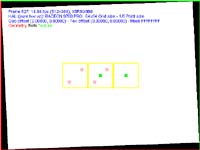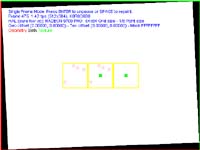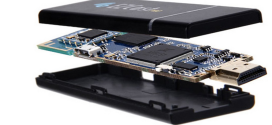Pixel and Texel fillrate of up to 8.4 Gigapixels/sec, up to 37 GB/sec of raw bandwidth and 12 or 16 pipeline architecture are the key features when it comes to X800 performance. Due to its sophisticated 0.13-micron Low-K dielectric process, very efficient GDDR3 memory interface and superior pixel shader architecture (12 or 16 pixel pipelines and 6 vertex units),RADEON X800 (x800 XT Platinum Edition) easily doubles the performance of its high-end predecessor RADEON 9800XT.
Introduction
Winter is over and as usual it is not only time for warm weather and green leaves on the trees. It is also time for new cards both from NVIDIA and ATI. Earlier in april we posted our first look at the NVIDIA GeForce 6800 Ultra and today it is time for us to talk about ATI’s new chipset, the x800.

While we unfortunately couldn’t get our hands on a GeForce 6800 Ulra for a preview ATI not only provided us with a referenceboard for benchmarking but they also invited us over to Toronto for a week to give us plenty of time to learn more about the new cards.
The Radeon x800 XT Platinum Edition and x800 Pro
With the new cards ATI has moved away from the Radeon 9×00 naming. The new cards are now called Radeon x800 XT Platinum Edition and Radeon x800 Pro.
The x800 XT Platinum Edition are the cards that goes head-to-head with the NVIDIA GeForce 6800 Ultra. Just as the 6800 Ultra, the x800 XT Platinum Edition has 16 rendering pipelines, DDR3 memory and high frequencies on both the VPU and the memory. The x800 pro is the little brother and ‘only’ has 12 rendering pipelines as well as a bit slower memory. Let’s take a look at the specs:
|
Radeon 9800XT
|
Radeon X800 Pro
|
Radeon X800 XT
Platinum Edition |
|
| Manufacturing: |
0.15-micron
|
0.13-micron low-k
|
0.13-micron low-k
|
| No of transistors: |
~115 mil.
|
~160 mil.
|
~160 mil.
|
| VPU speed: |
412 MHz
|
475 MHz
|
525 MHz
|
|
Pixel Pipelines/Pixel Fillrate: |
8 / 3300 MP/s
|
12 / 5700 MP/s
|
16 / 8400 MP/s
|
| TMU’s/Texel Fillrate: |
1 / 3300 MT/s
|
1 / 5700 MT/s
|
1 / 8400 MT/s
|
| Memoryspeed: |
730 MHz
|
900 MHz |
1150 MHz |
| Memory/Bandwidth: |
256-bit DDR1 / 23.4 GB/s
|
256-bit GDDR3 / 28,8 GB/s
|
256-bit GDDR3 / 36,8 GB/s
|
| Pixel Shader: |
2.0
|
2.0b
|
2.0b
|
| Vertex Shader: |
2.0
|
2.0
|
2.0
|
| FSAA: |
6x RGMS + Gammacorrect.
|
6x RGMS + Gammacorrect. + Temporal AA
|
6x RGMS + Gammacorrect. + Temporal AA
|
| Anisotropic Filtering: |
16x
|
16x
|
16x
|
| Connections: |
1x VGA, 1x DVI and 1x “S-Video” (HDTV)
|
1x VGA, 1x DVI and 1x “S-Video” (HDTV)
|
1x VGA, 1x DVI and 1x “S-Video” (HDTV)
|
| Recommended PSU: |
300w
|
300w
|
300w
|
| Other: |
1 slot
|
1 slot
|
1 slot
|
With the Radeon 9600 XT ATI started to use a .13 micron process and it is now time for them to move the process to their high-end cards. The process allows ATI to reach their high filrlates and core-clock while still keeping the heat low as well as the wattage needs low. Looking at the transistor count we see that even though the x800 has ~45 million more transitors than the Radeon 9800 XT it still is ~ 60 million less than the GeForce 6800 Ultra. Most of you already know that the NVIDIA GeForce 6800 Ultra demands a new 480W powersupply and I know there were rumours that the same would happen with the X800. It is therefore good news that ATI has managed to keep the need to the powersupply at the same level as for the radeon 9800 XT, a 300W powersupply.
On the x800 ATI has decided, just as NVIDIA, to go with the GDDR3 memory.
Without going into any details GDDR3 not only allows for higher clockrates but it also has other minor improvements.
With the NV40, NVIDIA decided to add PixelShader 3.0 support. ATI instead chose to stay with PixelShader 2.0 although the did move up to PS2.0b. They have done some improvements like increasing the instruction lenght from 150 to 1500 but there are no new features. When speaking to them about why they didn’t go with PS3.0 they claimed that they didn’t think this was necessary right now and that most of the PS3.0 features could be accomplished with PS2.0b anyway. it is hard to speculate right now if this is a bad move or not on their part since we do not know how extensive gamedevelopers will use PS3.0 features in upcoming games but, NVIDIA is definitely working hard in trying to get developers use PS3.0; if only for performance gains.
Looking at the card you noticed that it actually looks almost exactly like the Radeon 9800XT. When packing it to ship it to the next reviewer I actually almost packed the 9800XT instead. The main difference to the Radeon 9800 XT is that it does not have the huge copper-plate on the back of the card. The whole card is a bit easier than the Radeon 9800XT. While NVIDIA went with 2 DVI-connectors ATI still uses 1 VGA and 1 DVI. Since you can use a DVI => VGA adapter I think it would have been nicer if they used 2 DVI connectors instead.
Technical Information
Unlike ATI’s R300, used in the Radeon 9700 and considered a major leap in 3D architectures, the Radeon X800 series is very light on new features. In fact, only two items are not simply performance enhancements. First of all, we have Temporal Antialiasing, ATI’s name for three new antialiasing modes.Don’t worry, though; the X800 cards still have the option to use the highly-lauded antialiasing modes found on ATI’s R300 series, as well.
Before we can get into the specifics of temporal antialiasing, we need to examine the premises behind it. Temporal antialiasing relies on the idea that the human eye can filter out random noise very well. The concept of using random noise as a means to antialias a scene has been around for a very long time; known as stochastic antialiasing, it generates a new and random sample pattern for every pixel. Stochastic antialiasing is also considered by some to be the best possible form of antialiasing because it relies on both smoothing lines and creating noise to reduce aliasing artifacts. However, stochastic antialiasing has one huge drawback. If at least eight samples are not used, stochastic antialiasing looks terrible. The noise is too apparent and becomes a flicker at the edge of polygons, and image quality can actually be decreased. Even eight samples is not a great choice, as it still flickers at times. Sixteen samples is the threshold for excellent stochastic quality.
But, we obviously haven’t reached the point where sixteen samples is feasible for a gaming card. ATI has taken some of the concepts behind stochastic antialiasing and applied them to temporal antialiasing, an antialiasing method that requires no more samples than the R300 series. To accomplish this, temporal antialiasing relies on the R420’s chipset ability to dynamically change sample patterns. It goes something like this:
-
A single frame is rendered normally. Every pixel is antialiased with the same sample pattern, and the frame is output to the monitor.
-
Once the frame has finished rendering, the sample pattern is changed. The new sample pattern is not randomly generated as in stochastic antialiasing; it is simply a second sample pattern created for temporal antialiasing.
-
The next frame is rendered using the new sample pattern and output to the monitor.
-
Once this frame is completed, the sample pattern is reverted to the original, and the process repeats itself.
What this means is that by alternating sample patterns, temporal antialiasing creates some noise that is then reduced by the eye for improved image quality. The best part? There is no performance cost. However, temporal antialiasing is not without drawbacks. First, vertical sync must be enabled for temporal antialiasing to work at all. The tearing associated with the lack of vertical sync would become much worse with temporal antialiasing since half of the frame would have one sample pattern while the other would use a totally different pattern. Second, temporal antialiasing flickers except at high framerates. Since vertical sync forces the framerate to be, at maximum, the refresh rate of your monitor, better monitors will have more success with temporal antialiasing. Third, temporal antialiasing can occasionally reduce quality versus the regular rotated-grid multisampling found on R300 because of flickering and shimmering. This is true of high contrast edges in particular.
Let’s take a look at the sample patterns used in temporal antialiasing versus ATI’s classic rotated-grid patterns. Click on a thumbnail to see the full image.
|
Number of Samples |
Rotated-Grid Sample Pattern |
Temporal Sample Pattern A |
Temporal Sample Pattern B |
|
2 Samples |
|||
|
4 Samples |
|||
|
6 Samples |
Another interesting point is that temporal antialiasing works on the R300 series currently through the use of a registry key. R300 has the same capability for programmable sample patterns, and it works fine on those cards in Direct3D applications (it does not seem to work in OpenGL at this point in time). But, even more than temporal antialiasing itself, the most exciting part is that it indicates that ATI is moving in the direction of stochastic antialiasing and might even reach that goal with their next generation.
The second new feature found in the X800 series is, in my opinion, much less exciting than temporal antialiasing. It’s called 3Dc, and it’s a new compression scheme for normal maps. Normal mapping is a technique used to drastically reduce the number of polygons required for a realistic model–think of it as bump mapping on steroids. Doom 3, in particular, uses normal mapping everywhere to create such excellent graphics while keeping polygon count very low. 3Dc promises to increase the quality of normal maps while keeping the memory bandwidth required the same, since it was developed specifically for normal maps. The problem with 3Dc, though, is the same problem that faced Truform on the Radeon 8500: its success depends totally on developer support. Several games are using 3Dc, most notably Valve’s Half-Life 2, but unless it offers a fantastic image quality increase in real games, it will probably fade quickly just like Truform did.
|
|
|
Let’s meet Ruby
No launch would be complete without a demo, so let’s meet Ruby and see what ATI has come up with to “Promo” their new hardware.
NVIDIA has had Dawn and Nalu and ATI this time introduced Ruby.
The Ruby demo was made to not only show off some of the features of the Radeon x800 XT Platinum Edition but also to create a demo that in some aspects mimics the work of a gamedeveloper creating not only a character with tons of polygons, but also a complete enviroment and a story. ATI approaced a company called RhinoFX that do a lot of computer generated advertisement and together they created the Ruby demo. While it might not be as impressive as a demo where every inch of power is spent on 1 character I must say that I was impressed with it. The GFX was great and they used a lot of movie-type features like focus on the character while the background is off-focus. You can see for yourself by downloading and playing the Quicktime movie of it from the link below.
Here are some more screenshots from the demo. Click on each screenshot for a larger version.
 |
 |
  |
  |
Performance of the Radeon x800 XT Platinum Edition
ATI was nice enough to give me access to a x800 XT Platinum Edition to benchmark. Unfortunately a few issues kept me from doing extensive test with the card. A bad flash left the card dead and while I was able to get a replacement, I actually only had about 4 hours time in which to run the benchmarks. Hopefully in the not so distant future we will be able to do even more benchmarking on an x800 as well as test other features, like image quality. While I also wanted to compare the x800 XT with the GeForce 6800 Ultra I unfortunately didn’t have access to one of those. That also is something we hope to rememdy in the not so distant future.
My System:
| CPU |
AMD 64 3000+
|
| Motherboard |
Aopen AK86-L (Via K8T800)
|
| Memory |
1024 MB PC3200
|
| GFX |
Radeon 9800XT
Radeon x800 XT Platinum Edition |
| HD: |
80 GB ATA133, 60 GB ATA 133, 120 GB SATA
|
| Operative system |
Windows XP + SP1
|
| Drivers |
Catalyst 4.4 (9800XT)
Catalyst 4.5 Beta (x800 XT) |
| Benchmarks |
3DMark03
Far Cry Call of Duty X2- The Threat Shadermark 2.0 |
3DMark03
We start off the benchmarks with 3DMark03. Please note that my scores on my system always have been a bit low.
|
IQ Settings
@1024X768 |
9800 XT
|
x800 XT
Premium Edition |
IQ Settings |
9800 XT |
x800 XT |
|
no AA/no AF |
5,938 |
10,216 |
no AA/no AF |
2,777 |
10,231 |
|
4xAA / No AF |
3,703 |
6,409 |
4xAA / No AF |
2,774 |
4,987 |
|
6xAA/ no AF |
2,666 |
5,111 |
6xAA/ no AF |
1,934 |
3,926 |
|
4xAA/16xAF |
3,154 |
5,815 |
4xAA/16xAF |
2,325 |
4,555 |
|
6xAA/16xAF |
2,359 |
4,968 |
6xAA/16xAF |
1,731 |
3,815 |
As expected the x800 crushes the Radeon 9800 XT. With double the rendering pipelines and all that extra fillrate that is what we expect.
Call of Duty
To test the OpenGL performance I choose to record my own demo in Call of Duty (v1.3) on the map Brecourt.
|
IQ Settings
@1024X768 |
9800 XT
|
x800 XT
Premium Edition |
IQ Settings |
9800 XT |
x800 XT |
|
no AA/no AF |
98.6 fps |
104.7 fps |
no AA/no AF |
78.8 fps |
103.3 fps |
|
6xAA/16xAF |
48.7 fps |
92.6 fps |
6xAA/16xAF |
33.6 fps |
70.5 fps |
Once again the additional pipelines and the increased fillrate pays off, especially at a high AA and AF level. Playing a game at 1280×1024 with 6xAA and 16xAF is amazing with the x800 XT.
Far Cry
Tim decided to record a demo in Far Cry and see if we could create a good benchmark with the DX9 game. While the demo in the end still turned out to be pretty CPU-dependant I still think it shows off the x800 XT’s impressive performance.
|
IQ Settings
@1024X768 |
9800 XT
|
x800 XT
Premium Edition |
IQ Settings |
9800 XT |
x800 XT |
|
no AA/no AF |
66.9 fps |
69.4 fps |
no AA/no AF |
55.5 fps |
69.0 fps |
|
6xAA/16xAF |
49.6 fps |
69 fps |
6xAA/16xAF |
33.6 fps |
64.0 fps |
In actual gameplay the x800 XT still flies high above the Radeon 9800XT. There really is no comparison.
ShaderMark 2.0
To test the performance of the Pixelshader I used the program ShaderMark 2.0.
|
ShaderMark2.0 |
9800 XT
|
x800 XT Platinum Edition
|
| Per Pixel Diffuse Lighting |
306 fps |
721 fps |
| Per Pixel Directional Light Shader (Phong) |
231 fps
|
575 fps
|
| Per Pixel Point Light Shader (Phong) |
219 fps
|
556 fps
|
| Per Pixel Spot Light Shader (Phong) |
198 fps
|
496 fps
|
| Per Pixel Anisotropic Lighting |
225 fps
|
575 fps
|
| Per Pixel Fresnel Reflections |
219 fps
|
531 fps
|
| Per Pixel BRDF-Phong/Anisotropic Lighting |
168 fps
|
398 fps
|
| Per Pixel Car Surface Shader |
151 fps
|
381 fps
|
| Per Pixel Environment Mapping |
357 fps
|
831 fps
|
| Per Pixel Environment Bump Mapping |
283 fps
|
671 fps
|
| Per Pixel Bump Mapping |
198 fps
|
516 fps
|
| Per Pixel Shadowed Bump Mapping |
103 fps
|
258 fps
|
| Per Pixel Veined Marble Shader |
102 fps
|
351 fps
|
| Per Pixel Wood Shader |
157 fps
|
431 fps
|
| Per Pixel Tile Shader |
103 fps
|
272 fps
|
| Fur Shader With Anisotropic Lighting |
16 fps
|
40 fps
|
| Per Pixel Refraction and Reflection Shader with Phong Lighting |
151 fps
|
378 fps
|
| Dual Depth Shadow Mapping With 3×3 Bilinear Percentage Closer Filter |
31 fps
|
78 fps
|
| High Dynamic Range Shader (cross blur) |
70 fps
|
198 fps
|
| High Dynamic Range Shader (gaussian blur) |
77 fps
|
217 fps
|
| Per Pixel Edge Detection And Hatching Shader |
46 fps
|
115 fps
|
| Per Pixel Water Colour Shader |
53 fps
|
70 fps
|
Can I say … wow?
X2 – The Thread rolling Demo
Last but not least i spun up the rolling demo of X2 – The threat. Even though the performance of the rolling demo isn’t directly related to the performance in the game it still is testing a variety of situations that you could find in games.
As long as the scene isn’t CPU-dependant the x800 XT as expected once again performs excellent.
Performance Conclusion
If you were a bit dissapointed in the leap from Radeon 9700 pro to Radeon 9800 Pro or Radeon 9800 Pro to Radeon 9800XT then you will be extremely happy with the performance leap of the x800 XT. The 8 extra rendering pipelines as well as increased VPU and memory speed really helps the x800 XT to simply crush the Radeon 9800XT. If you could play at 4x AA and 8xAF on the Radeon 9800XT and get good framerates you now can play at 6xAA and 16xAF and still get higher performance. Impressive? Definitely. Since I couldn’t test the 12 pipeline x800 Pro in time for this preview I cannot say to much about its performance more than that in theory it will still perform really good compared to the Radeon 9800XT.
IQ at a minimal cost
Pixel and Texel fillrate of up to 8.4 Gigapixels/sec, up to 37 GB/sec of raw bandwidth and 12 or 16 pipeline architecture are the key features when it comes to X800 performance. Due to its sophisticated 0.13-micron Low-K dielectric process, very efficient GDDR3 memory interface and superior pixel shader architecture (12 or 16 pixel pipelines and 6 vertex units), RADEON X800 easily doubles (x800 XT Platinum Edition) the performance of its high-end predecessor RADEON 9800XT.
There is no doubt in our minds that the new RADEON X800 from ATI has just raised the image quality bar. By introducing Temporal Antialiasing, this technique brings in huge quality enhancements while keeping performance cost at zero. This is truly a step forward when it comes to programmable Antialiasing architecture. As with R3xx design, X800 offers full trilinear texture filtering by default along with up to 16x Anisotropic Filtering. When combined, the video output is phenomenal keeping the performance hit at minimal — in some situations none-existent because of X800s superior fillrate.
Conclusion
With the x800 Pro and XT Platinum Edition ATI has brought up a pair of impressive products. If there is something one could complain about is that the cards really do not have any new exciting features and that they basically still are R300 on crack. I don’t necessarily think that the lack of PS3.0 will affect this generation though and the performance increase itself is enough to have any serious gamer wanting it. Any price-concious gamers should take a closer look at the Radeon x800 Pro which should perform excellent while be a lot more affordable.
The x800 pro should be out as you read this at a suggested retail price of $399 and the x800 XT Platinum Edition will be out on the 21st of May at a suggested retail price of $499.
 Bjorn3D.com Bjorn3d.com – Satisfying Your Daily Tech Cravings Since 1996
Bjorn3D.com Bjorn3d.com – Satisfying Your Daily Tech Cravings Since 1996

















